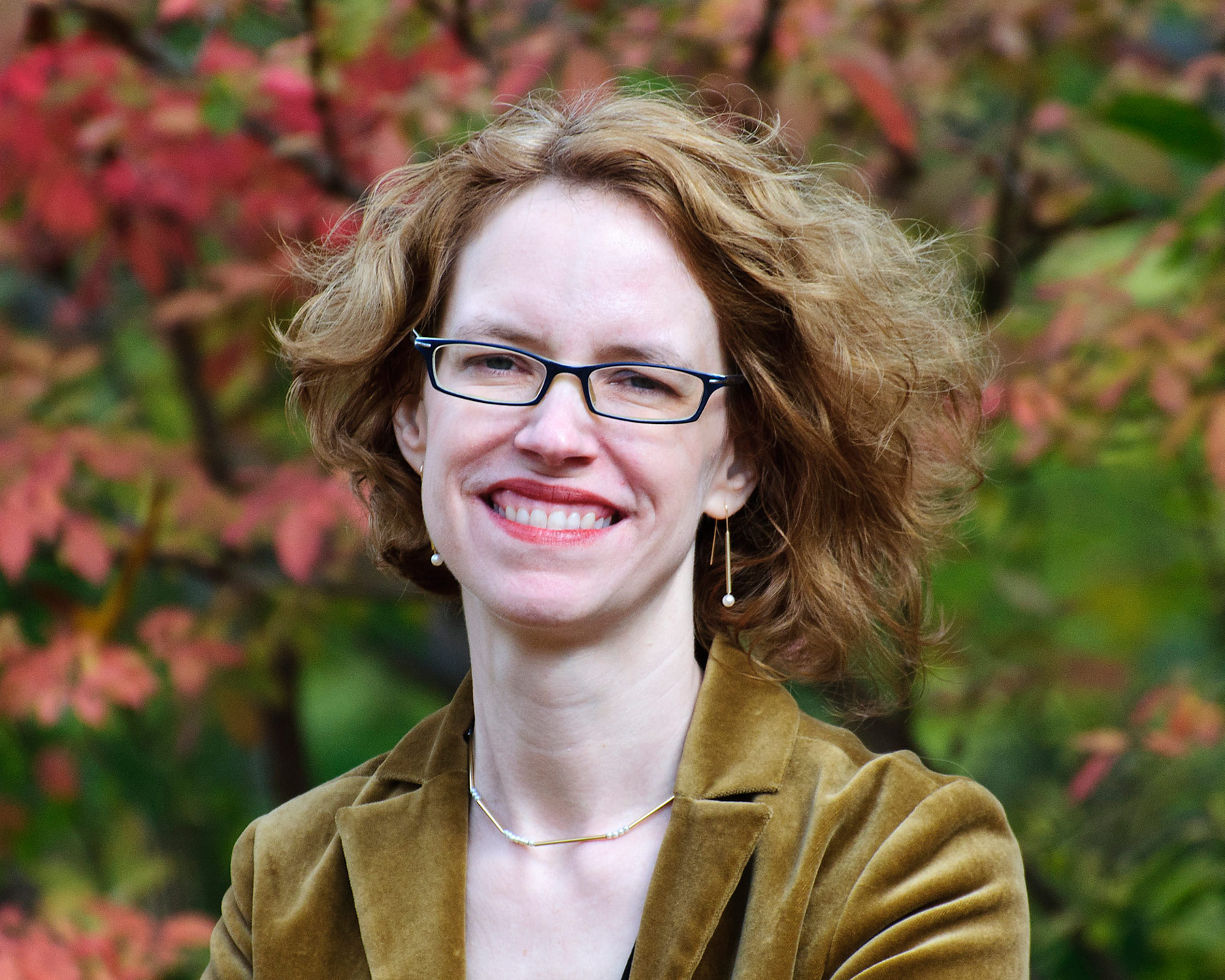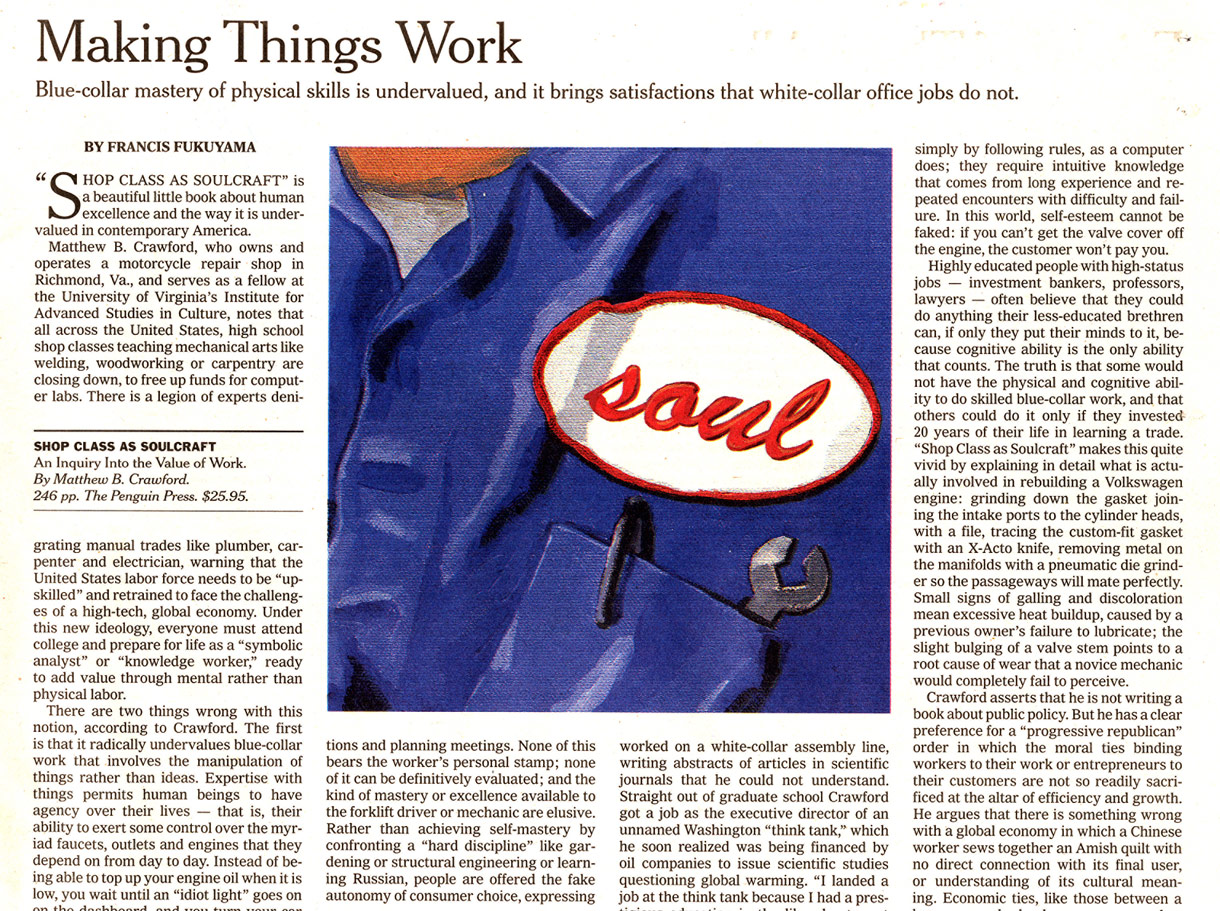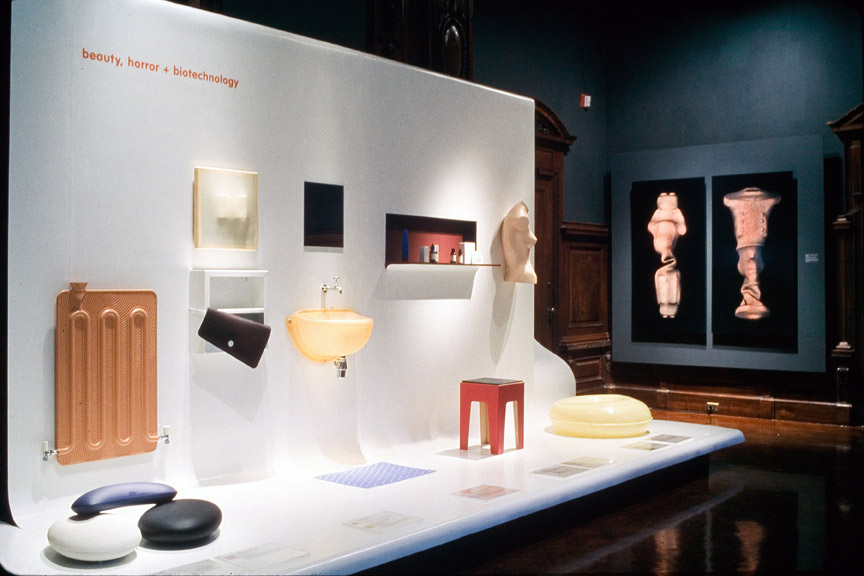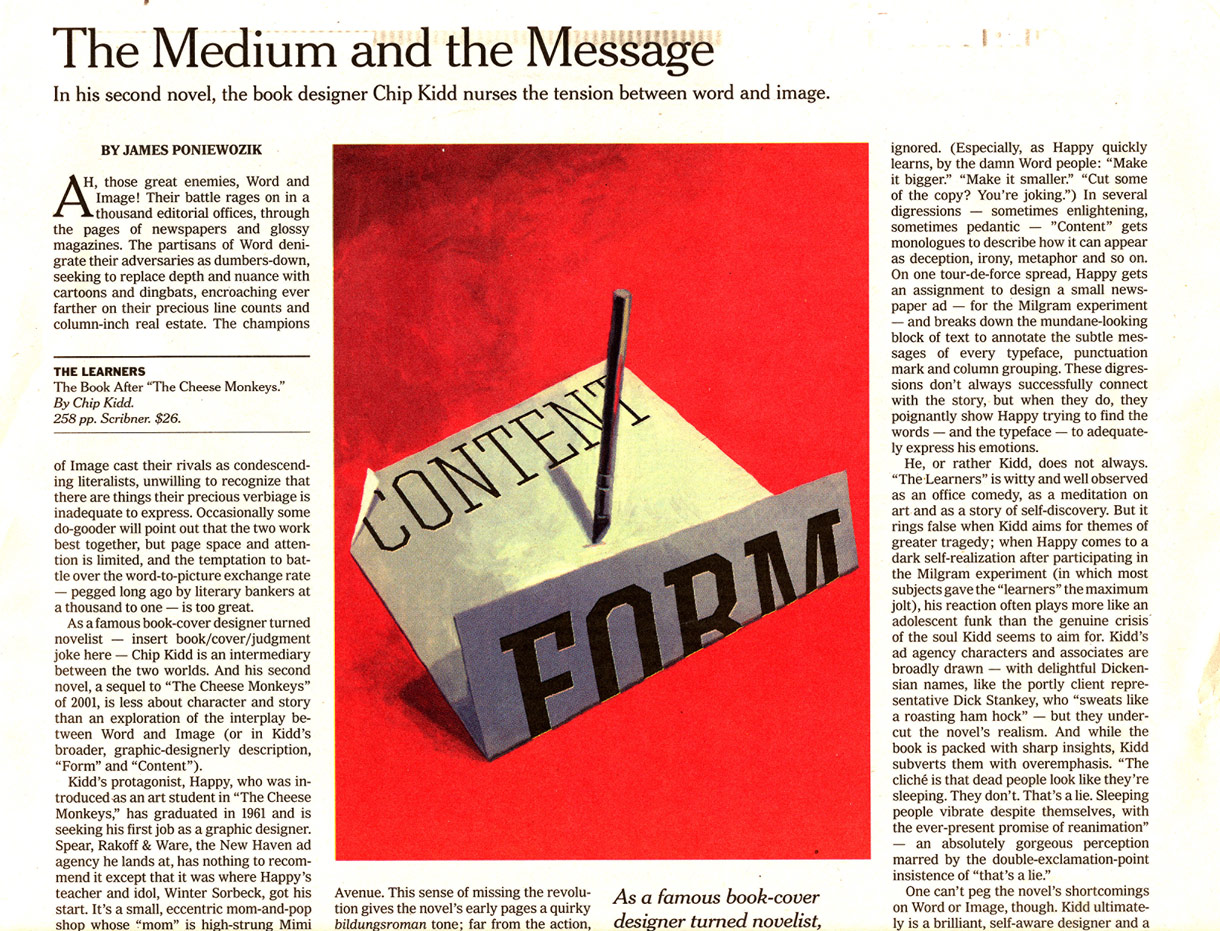
- Interview by Tina Essmaker April 15, 2014
- Photo by Sally Foster
Ellen Lupton
- curator
- designer
- educator
- writer
Ellen Lupton is curator of contemporary design at Cooper-Hewitt, National Design Museum in New York City and director of the Graphic Design MFA program at Maryland Institute College of Art (MICA) in Baltimore. An author of numerous books and articles on design, she is a public-minded critic, frequent lecturer, and AIGA Gold Medalist.
Interview
Describe your path to what you’re doing now.
In the 1980s, I went to art school at Cooper Union and studied graphic design, fine art, writing, and the humanities. When I graduated, I was asked to run a design gallery on campus. That experience was my start to becoming a curator. I worked there for seven years, built up a body of work, and then, in 1992, I went to work as a curator at Cooper-Hewitt, the Smithsonian’s national design museum; I’ve been there ever since. It’s a bigger, more public job that includes things like organizing exhibitions around design and planning and hosting events. For example, I organized a traveling exhibition about contemporary design opening at Rhode Island School of Design (RISD) next week called Graphic Design: Now in Production. In the fall, I will open the exhibition Beautiful Users, which is about user-centered design and the role of the user in design thinking.
For the past 15 years, I have worked part-time for Cooper-Hewitt and taught at Maryland Institute College of Art (MICA) in Baltimore, where I live. I run MICA’s Graphic Design MFA program, which is for young professionals who want to reinvent themselves, learn new things, and be in a community of super-intense peers.
I enjoy doing a variety of things: teaching, lecturing, curating, and publishing. To me, those are all public activities that involve different aspects of design.
Are you here in New York City a few days during the week and in Baltimore the remainder of the time?
I’m in New York one day a week and in Baltimore the rest.
Going back farther than that, was creativity part of your childhood? And how did you decide what you wanted to do?
I have an identical twin sister. As we were growing up, she was the more academic twin, more focused on school; she was a writer and scholar, and I was a visual artist and bohemian. We created those identities early on: she was a serious student and I was an artist. Because of that, I ended up going to art school. My sister went to Johns Hopkins University, a very rigorous school, and then she went on to earn her doctorate at Yale. Even though I went to art school, I took my career in a somewhat academic direction—I guess my sister and I were more alike than we thought we were. I set out to be an artist, but I made my career as an educator and writer.
And you and your sister, Julia, have collaborated on projects together?
Yes. We did a kid’s design book called DIY Kids and we did a book for adult women called Design Your Life. They’re both books that invite everyone to participate in the design process.
Are you writing any books right now?
Yes. I’ve written many creative guides to design practice, including Thinking with Type. I’m always working on those, some of which I work on with my graduate students and other faculty. Right now, I’m writing a book with Cooper-Hewitt, and I’m writing a novel in my spare time.
A fiction book?
Yes.
Nice.
I try to keep a lot of projects going at once, which means I always have something challenging and fun and new to work on.
Were you raised in Baltimore?
I was. I came to New York for school and stayed there for 15 years. Then I went back to Baltimore, but kept a part-time job in New York, so I could still have an existence there. (laughing)
What was it like leaving Baltimore and going to New York City for college?
I loved New York, but school took a lot of focus and was very hard. I never got into the club scene. My school was two blocks from New York University and that was a totally different scene with lots of partying, but students at Cooper Union worked really hard. I think high school was my wild, party girl time; when I went to college, I grew up.

“It was in college when I realized that graphic design was all about writing—that was an unbelievable discovery for me. I had always viewed writing and art as two separate things…”
As a side note, what was it like going to school for design in the ’80s? Were you one of few women in the program?
There were always plenty of women studying at the school, but there were fewer women getting hired into positions of influence, and those are the women you know about. If you listed the 10 most well-known designers, most would be men. Today, there are more women in the field, but it’s still hard. I think our role in childbearing is different and a lot of educated women decide they don’t want to work full-throttle for a variety of reasons, including wanting to devote more time to their children. To do that, you have to cut things out of your life. It can be tough for men, too; everybody’s career gets hit by the demands of parenting, but as a group, women tend to get hit more. It’s partly voluntary, but it’s also because if one person in a partnership has a higher income, it’s natural that the other is going to stay home.
And it’s likely that men will have a higher income.
There are a lot of factors in that, but the circumstances do depress the role of women in design and many other fields.
Have you had any mentors along the way?
When I was in college, I met my husband, Abbott Miller, who is an amazing designer. We became best friends in school and, later, we became boyfriend and girlfriend and married—but in school, we were mostly just friends. Those years were a unique time to look at design more critically, not just as a business, but as a discourse. We were inspired by many of our teachers, including George Sadek, P. Adams Sitney, and Hans Haacke. Today, design has a vibrant, young subculture, but when we were in school, the voice of the field was dominated by older people with decades-long careers. The AIGA was full of well-established, middle-aged designers who represented a certain degree of accomplishment in the profession, but there wasn’t much of a conversation about design. Now, it’s so much different. Back then, we had fun trying to start a conversation about looking at design in a more critical way.
The Internet has given people an opportunity to talk about design. Now, anyone can share their thoughts—
—or their work. It has completely changed the way young designers enter the field; it has become much more welcoming to them. There are more clients now, too. The barrier to entry is lower for everyone, because everyone needs design. It used to be that only a certain level of businesses needed a designer, but now every little coffee shop and bakery and corner store has branding and a website. Everybody is taking part in design.
Definitely. So, what I want to know is who made the first move—you or your husband?
I was always trying to put the moves on him, but he was very monastic and resistant to that sort of thing. (laughing) Eventually, he came around.
Did you have an “Aha!” moment when you knew what you wanted to do?
It was in college when I realized that graphic design was all about writing—that was an unbelievable discovery for me. I had always viewed writing and art as two separate things; I had chosen the art path and my sister had picked the writing path. I knew that I liked language and words, especially cartoons and visual puns. Even in high school, I liked creating conceptual illustrations that were visually funny, but I never saw myself as a writer. Then I took a typography class at Cooper Union and realized there was an intimate relationship between writing and design. Prior to that, I had no idea what typography was; back in the ’80s, it wasn’t as accessible. Typography wasn’t something you could just do.

“You have to be prepared to give creative work 150%. I hear a lot of young people talking about life/work balance, which I think is great when you’re in your 30s. If you’re in your 20s and already talking about that, I don’t think you will achieve your goals.”
Has there been a point when you’ve decided to take a big risk to move forward?
I think having kids was a big risk. Leaving New York was also big risk.
But you left New York for the opportunity to teach?
I did, but it was still scary to work two jobs and live in two places. My husband and I wanted to have space to breathe, indoors and out, and I wanted to be closer to family and be in a place that was easier to raise kids in, but still a city—I didn’t want to be in the suburbs. It was a really big, really hard decision, but I’m happy with it.
Are your family and friends supportive of what you do?
My family is really supportive, and I’m very close to them. I have a few close friends. As you get older, it becomes harder to make friends; people are already paired off and have strict routines. It’s not the same as when you’re in college. But I’ve worked hard to maintain a couple of very important friendships, which are life-sustaining to me. Overall, I feel like I have enough people around me; I’m able to give them enough care and attention and they support me.
Do you feel a responsibility to contribute to something bigger than yourself?
I think that’s why I do the things I do; they are outward and public. Teaching is very much a giving profession, and I put a lot of mental energy and time into it. Time is all we really have, and teachers give their time to others. The other things I do—writing, lecturing, and curating—are about sharing something of value.
Are you creatively satisfied?
I’d say I’m 80% satisfied. I’m always too busy, but that’s a choice, and, for me, I tend to be more productive that way. When I’m not too busy, I don’t tend to get more done. When you are super-busy, you enter a state of frenzy that can be enormously scary and rewarding and productive. I don’t know that I’d be more satisfied if I only had one job or if I had more time.
Is there anything you’re interested in doing in the next 5 to 10 years?
I want to finish my novel. That’s my one thing I’m working on that’s just for me.
What is it about?
It’s about a young woman in the near future who is entering the design world and having adventures; it’s a satirical, humorous account of life as a designer. Writing fiction is fun, but very labor-intensive. I wish I had more time to spend on it, but it’s my responsibility to make time to do the things I want—I can’t blame anyone else.
What advice would you give to someone starting out?
You have to be prepared to give creative work 150%. I hear a lot of young people talking about life/work balance, which I think is great when you’re in your 30s. If you’re in your 20s and already talking about that, I don’t think you will achieve your goals. If you really want to build a powerful career, and make an impact, then you have to be prepared to put in blood, sweat, and tears. I don’t think everybody is willing to do that, but if you have the opportunity to do so, you should. That’s why many people go to graduate school in their late 20s: it forces them to devote intense time and focus to their work. It’s an experience that will change you forever.
That’s great advice. How does where you live impact your creativity? Or, since you spend time in New York and Baltimore, how does each place influence you?
I love having both places. When I’m in New York, I’m very busy running around and meeting people. I’m not sitting at a desk all day, and that’s exciting for me. In Baltimore, I work from home and at the school, but any real writing or producing happens at home. There are days when I’m in my head, sitting in a beautiful room with views of the trees outside, with my little dogs at my side. Having an environment like that is conducive to work, and it’s really great, but I’d be bored if I couldn’t also get out and be around others.
Speaking of being around others, is it important to you to be part of a creative community?
Yes. Sharing is the whole point of doing creative work. I love being part of a museum and college community; I like doing lectures and being an author because I have readers and the general public to respond to. In return, I also share other people’s work, read their writing, and go to their lectures and exhibitions. Taking part in the community is important.
What does a typical day look like?
I get up very early, usually around 5am, and I’m really intense all day. I spend most of the day working, which includes a lot of dumb managerial stuff, but creative work, too. In the evening, I cook, watch TV, and hang out with my husband and family for a couple hours. Then I go to bed at 10pm.
Do you have any favorite music?
It’s embarrassing, but all I listen to is NPR; (laughing) I listen to it in the car. When I’m working, I don’t listen to music, because I have to be mentally present.
Any favorite movies or TV shows?
I love TV! I watch House of Cards, Masters of Sex, Breaking Bad, Mad Men, True Detective. There are so many good shows, and I enjoy following the characters over time.
Do you have a favorite book?
I love all the books of Kurt Vonnegut; he’s a really important historical writer for me. I also like Joyce Carol Oates, Alice Sebold, Don DeLillo, Jonathan Franzen—all the typical authors of my generation.
Do you have any favorite design or typography books that you recommend to your students?
Definitely The Elements of Typographic Style by Robert Bringhurst, which is super important. Emil Ruder’s book Typography from the ’60s is amazing. There’s also a satisfying history book called Graphic Design: A Concise History, by Richard Hollis, which is $14.95 and can be read in a few hours; it’s an instant, smart, well-written exposure to the world of graphic design.
What is your favorite food?
Any kind of vegetables or fish.
What kind of legacy do you hope to leave?
(laughing) Well, I have made a point of writing and publishing beginning when I was in my early 20s. Back then, it had to be print and I’m glad, because print is so permanent. Publishing has always been the core of my work, and it’s a record of everything I’ve done. I’m proud of it. I want to keep publishing in whatever form it takes—digital or video—but I always want the written word to be part of what I do, because that’s what lasts.
“Publishing has always been the core of my work, and it’s a record of everything I’ve done. I’m proud of it. I want to keep publishing in whatever form it takes—digital or video—but I always want the written word to be part of what I do, because that’s what lasts.”

